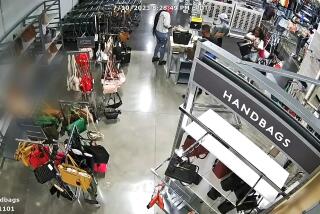Study May Help Riverside Close Upscale-Retail Gap
- Share via
Riverside wants a more upscale image, but is getting little help from the Banana Republics of the world.
The city badly wants to lure higher-end shops and restaurants to the area, including Crate and Barrel, Restoration Hardware and P.F. Chang’s, but has found the effort to be a tough sell. Those retailers depend on market studies when deciding where to open shops, and Riverside rarely makes the cut.
So the city is lobbying stores and restaurants to change the way they analyze the Riverside market, giving more weight to the city’s richest households and excising the college students who drag down Riverside’s median income.
Deputy City Manager Mike Beck said a city-commissioned study presented to the City Council on Tuesday night proves what the city had been telling retailers: “Riverside has a wealthy community with significant depth and demands for more boutique or higher-end retail and restaurants.”
Time and again, he said, when the city persuaded a retail or restaurant chain to open in Riverside, it far outperformed expectations: Barnes & Noble, Cafe Sevilla, Trader Joe’s and Starbucks are examples.
Despite those successes, other retailers still balk.
“They say, ‘Our studies say we shouldn’t be there yet,’ ” said John E. Husing, who conducted the study for the city. Husing, an Inland Empire economist, was paid $5,000 for the 11-page retail analysis.
A primary reason Riverside has been shunned is the city’s median household income: $57,094, a number that the study says is grossly misleading.
Looking at the sheer number of households with higher incomes, Riverside is on par with some of the toniest communities in Southern California.
It has more households earning more than $75,000 than Newport Beach, Glendale, Thousand Oaks, Simi Valley and Mission Viejo, according to Husing’s study. The city also has 20,000 college students, at UC Riverside, La Sierra University and California Baptist University.
Although they make less than $10,000, parental support and shopping habits mean they often spend far more, the study concluded . But retailers said that although income is one factor they consider when evaluating potential locations, it is not the only one.
“We don’t look at just strictly median income, because of exactly what [the city is] saying,” said Gap Inc. spokeswoman Jordan Benjamin.
“That’s why we look at, more specifically, customers ... not so much how much people have, but what are their shopping behaviors?”
When considering new locations, she said, the company studies existing stores, customer base, capital costs and potential return. San Francisco-based Gap Inc. owns Banana Republic, Gap and Old Navy. There is a Gap at the Galleria at Tyler in Riverside, but the closest Banana Republics are an hour or more away, in Palm Springs, Pasadena, Long Beach, Brea, Costa Mesa or Newport Beach.
Regional planners were skeptical about how successful the city would be in its efforts to land more stores such as Banana Republic. “I find that retailers are surprisingly stubborn about what they want to believe,” said Bill Fulton, a senior scholar at USC’s School of Policy, Planning and Development.
More to Read
Inside the business of entertainment
The Wide Shot brings you news, analysis and insights on everything from streaming wars to production — and what it all means for the future.
You may occasionally receive promotional content from the Los Angeles Times.











